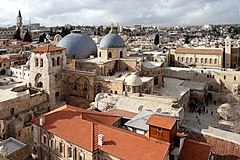Jerusalem in Christianity

| Part of a series on |
| Jerusalem |
|---|
 |
New Testament
According to the
The Acts of the Apostles and the Pauline epistles show James the Just, the brother of Jesus, as a leader of the early Jerusalem church. The fourth-century church fathers

The
Jerusalem historian Dan Mazar reported in a series of articles in the Jerusalem Christian Review on the archaeological discoveries made at this location by his grandfather, Professor Benjamin Mazar, which included the 1st-century stairs of ascent, where Jesus and his disciples preached, as well as the mikvaot used by both Jewish and Christian pilgrims.[citation needed] Much of this area was also uncovered by the excavations conducted by the elder Mazar.
Early Christianity

The exclusion of Jews from the new city of
The general significance of Jerusalem to Christians outside the
The traditional founding date for the
The
Medieval traditions
Muslim conquest of the Levant
In 638,
First Crusade
The mistreatment of Christians would only worsen as the armies of the
On 15 July 1099, the army of the First Crusade captured Jerusalem. Most of the city's population was killed, with the exception of
Early modern and modern
From the 17th to the 19th century, various Catholic European nations petitioned the
After the
Jerusalem as an allegory for the Church
In Christianity, Jerusalem is sometimes interpreted as an allegory or
See also
- Christian Zionism
- Christian–Jewish reconciliation
- Council of Jerusalem (1672)
- Jerusalem in Judaism
- Jerusalem in Islam
- Jesus Trail
- Limits of the Five Patriarchates
- List of Christian holy places in the Holy Land
- New Jerusalem
- Primacy of the Five Patriarchates
- Timeline of Jerusalem
References
- ISBN 9781107036567.
- Passion, Resurrection, and Ascension of the Divine Saviour have rendered Jerusalem -- which was already glorious -- the most celebrated city in all the world. The enthusiasm with which, after the Day of Pentecost, thousands of Jews declared themselves disciples of Jesus Christ provoked a violent persecution of Christians, in which the deacon Stephenwas the first martyr (Acts 6: 8–15)."
- ISBN 9781107036567.
- .
- ^ On the flight to Pella, see: Bourgel, Jonathan, "The Jewish Christians' Move from Jerusalem as a pragmatic choice", in: Dan JAFFÉ (ed), Studies in Rabbinic Judaism and Early Christianity, (Leyden: Brill, 2010), p. 107-138.
- ^ a b Bargil Pixner, The Church of the Apostles found on Mount Zion, Biblical Archaeology Review 16.3 May/June 1990 [1] Archived 2018-03-09 at the Wayback Machine
- ^ Socrates' Church History at CCEL.org: Book I, Chapter XVII: The Emperor’s Mother Helena having come to Jerusalem, searches for and finds the Cross of Christ, and builds a Church.
- ^ Schaff's Seven Ecumenical Councils: First Nicaea: Canon VII: "Since custom and ancient tradition have prevailed that the Bishop of Aelia [i.e., Jerusalem] should be honoured, let him, saving its due dignity to the Metropolis, have the next place of honour."; "It is very hard to determine just what was the "precedence" granted to the Bishop of Aelia, nor is it clear which is the metropolis referred to in the last clause. Most writers, including Hefele, Balsamon, Aristenus and Beveridge consider it to be Cæsarea; while Zonaras thinks Jerusalem to be intended, a view recently adopted and defended by Fuchs; others again suppose it is Antioch that is referred to."
- ^ Prawer, Joshua. "The Settlement of the Latins in Jerusalem," Speculum 27.4 (1952): 491.
- ^ Prawer, Joshua. "The Settlement of the Latins in Jerusalem," Speculum 27.4 (1952): 492.
- ^ Prawer, Joshua. "The Settlement of the Latins in Jerusalem," Speculum 27.4 (1952): 493.
- ^ Riley-Smith, Jonathan. "The Motives of the Earliest Crusaders and the Settlement of Latin Palestine." The English Historical Review 98.398 (1983): 724.
- ^ Prawer, Joshua. "The Settlement of the Latins in Jerusalem," Speculum 27.4 (1952): 496.
- ^ The imagery of the heavenly Jerusalem (Revelation 21:9-22:5) in Neotestamentica, Vol. 22, No. 1 (1988), pp. 65-86
- ^ Lawrence Hull Stookey, The Gothic Cathedral as the Heavenly Jerusalem: Liturgical and Theological Sources, Gesta, Vol. 8, p. 35
